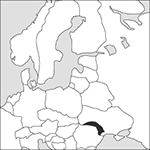
Source: MAPS IN MINUTES™ © RH Publications (1997)
Capital:
Chisinau
Area:
33,851 sq km (13,070 sq miles)
Population:
3,619,925 (2013 est)
Currency:
1 leu=100 bani
Religions:
Eastern Orthodox 98.0%; Jewish 1.5%
Ethnic Groups:
Moldovan (Romanian) 78.2%; Ukrainian 8.4%; Russian 5.8%
Languages:
Moldovan (Romanian; official); Russian; minority languages
International Organizations:
UN; OSCE; Commonwealth of Independent States; Euro-Atlantic Partnership Council; Council of Europe; WTO
A country in eastern Europe bounded on the north, east, and south by Ukraine, and on the west by Romania. Wider Moldova comprises lands between the Carpathian Mountains in the west and the Dneister River in the east, including the north-east of modern Romania.
Physical
The Prut River waters the western part of Moldova, Bessarabia. Although landlocked, its proximity to the Black Sea gives it a mild climate. From the north into the centre runs a belt of hills with deep valleys in which vines and fruit trees flourish. Further south are low-lying steppes supporting grain, sugar beet, and tobacco.
Economy
Moldova’s mineral resources are meagre, but the soil is fertile and agriculture prospers, with viticulture, fruits and vegetables, and tobacco. Industry concentrates on food processing, machinery, domestic appliances, clothing, and textiles; food products, textiles, and machinery are the principle exports. Expatriate remittances are important.
History
Moldova at one time formed part of Bessarabia, control over which was long disputed between Russians and Ottoman Turks, Russian occupation being confirmed in 1812. Although at first granted autonomy (1818–28), this was succeeded by a policy of Russification. A nationalist movement developed from 1905 and in November 1917 Bessarabia declared independence, voting in December 1918 for alliance with Romania. In June 1940 the Soviet Union demanded the return of Bessarabia and of northern Bukovina, and the Moldavian Soviet Socialist Republic was created. The northern region of Bukovina and the coastal plain from the Danube to the Dniester went to the Ukraine. Romania briefly reoccupied the area in 1941, but the 1940 situation was restored in 1947. In August 1991 the country declared its independence from the Soviet Union as the Republic of Moldova. The regions of Transdniestria and Gagauz also declared themselves to be separate republics, but their declarations were annulled by the Moldovan government. Ethnic violence broke out in Transdniestria and Russian troops were sent in to protect Russian residents. A strong movement for Moldovan unification with Romania increased interethnic tensions. However, Moldova’s first multiparty elections, held in 1994, were won by supporters of Moldovan independence. A new constitution granted autonomous status to the Transdniestria and Gagauz regions but the situation remains unresolved, with Transdniestria being effectively an independent state beyond Moldovan control. Constitutional conflicts between the President and parliament from the late 1990s led to a reduction of presidential powers in 2000.
The Communists returned to power in the 2001 elections and governed Moldova until 2009, when they were replaced by a four-party pro-EU coalition led by Vladimir Filat. He stood down in 2013, and later that year Moldova signed an Association Agreement with the EU, much to the displeasure of Russia, which banned imports of Moldovan agricultural products(to join a ban on Moldovan wine). In 2015 the government was engulfed in an immense banking fraud that removed over $1 billion US dollars (an eighth of Moldova’s GDP) from the reserves of Moldova’s main banks. It saw Filat charged with corruption, the resignation of another Prime Minister, and the dismissal of the whole government by Parliament in October 2015. When a new government was formed in January 2016, led by Pavel Filip, of the pro-EU Democratic Party, it immediately faced massive anti-corruption and pro-Russian street protests. Later in 2016, the pro-Russian Igor Dodon won the first direct election of a president in 20 years.
- Lamarck, Jean Baptiste Pierre Antoine de Monet, Chevalier de
- Lamarck, Jean Baptiste Pierre Antoine de Monet, Chevalier de (1744–1829)
- Synge, Richard Laurence Millington
- synkinematic
- synneusis
- synodic
- synodic month
- synodic period
- synomone
- synonym
- synonymous substitution
- synonym ring
- Synopsys
- synoptic
- synoptic meteorology
- synorogenic
- synovial membrane
- synperiplanar
- synrhabdosome
- synroc
- synrock
- synsacrum
- synsedimentary fault
- synsedimentary fold
- syntactic consequence